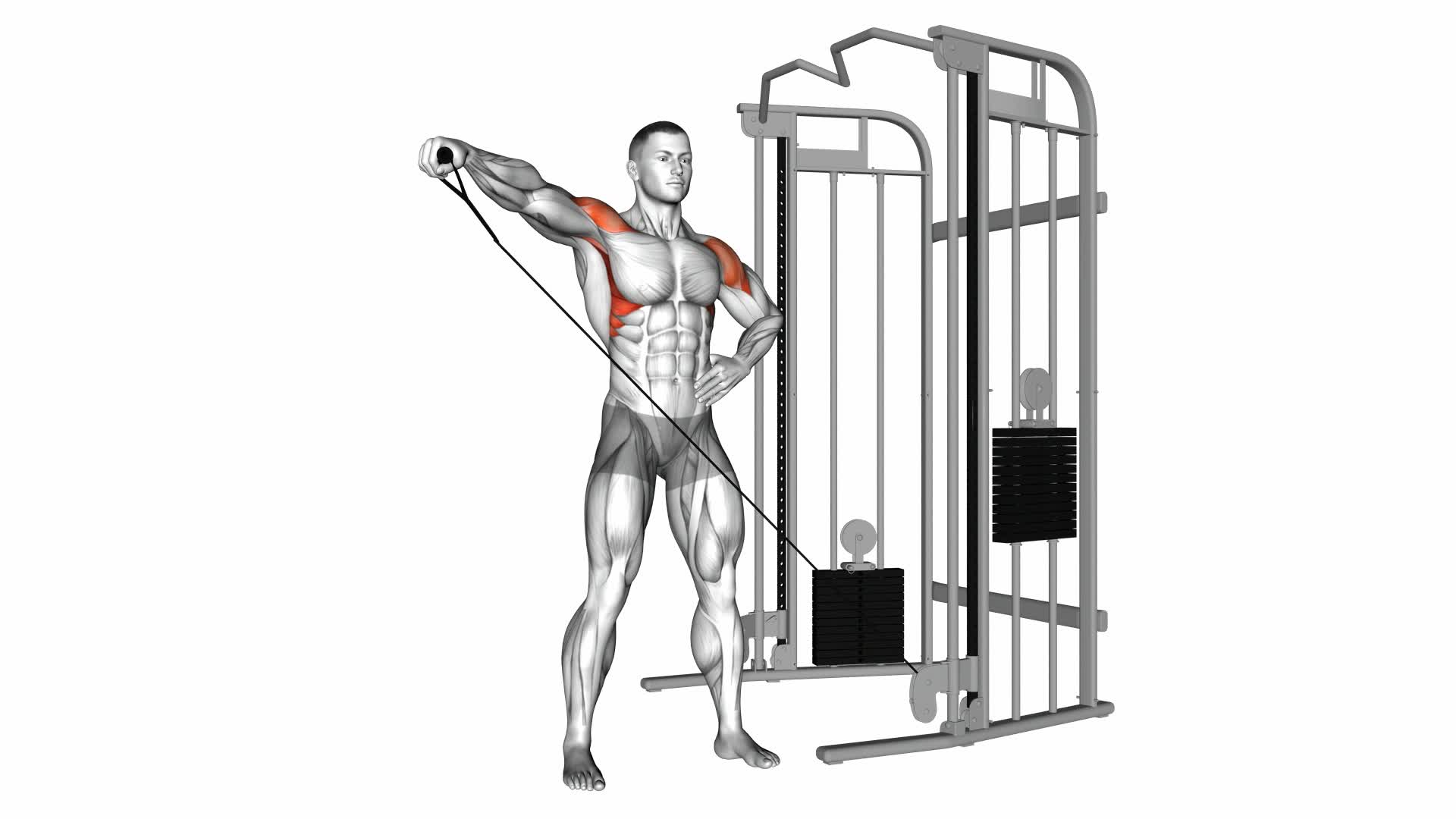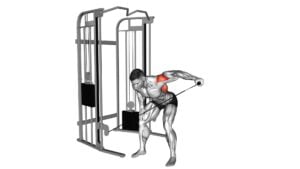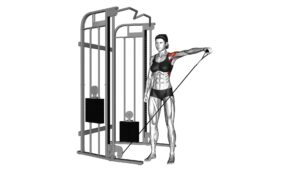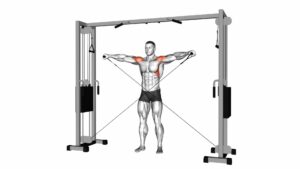Cable One Arm Lateral Raise – Video Exercise Guide & Tips

If you're looking to strengthen and tone your shoulders, the Cable One Arm Lateral Raise is the exercise for you.
Watch This Exercise Video
In this video exercise guide, we'll show you the proper form and technique to maximize your results.
You'll also learn how to choose the right weight and equipment, avoid common mistakes, and discover variations for added challenge.
Follow our tips for a safe and effective workout that will leave you feeling strong and confident.
Let's get started!
Key Takeaways
- Cable one arm lateral raise targets the shoulder muscles, specifically the deltoids.
- It strengthens and tones the deltoids for defined shoulders.
- The exercise engages the trapezius muscles for improved posture and stability.
- It enhances shoulder mobility and flexibility.
Benefits of Cable One Arm Lateral Raise
To maximize your workout, it's important to understand the benefits of performing the Cable One Arm Lateral Raise exercise. This exercise specifically targets your shoulder muscles, providing several key benefits.
Firstly, it helps to strengthen and tone your deltoids, which are the main muscles responsible for shoulder movement. By regularly incorporating this exercise into your routine, you can develop stronger and more defined shoulders.
Additionally, the Cable One Arm Lateral Raise also engages your trapezius muscles, helping to improve posture and stability in your upper body.
This exercise can also help to improve shoulder mobility and flexibility, which is crucial for activities that require a wide range of motion, such as throwing a ball or reaching overhead.
Lastly, the Cable One Arm Lateral Raise can be a great exercise for targeting imbalances between your left and right shoulder muscles. By working each arm individually, you can ensure that both sides of your body are equally strong and balanced.
Proper Form and Technique
To perform the Cable One Arm Lateral Raise exercise with proper form and technique, follow these steps:
- Start by grabbing the cable handle with your hand.
- Stand with your feet shoulder-width apart and maintain a slight bend in your knees.
- Keep your core engaged and your back straight throughout the exercise.
To execute the movement:
- Slowly raise your arm out to the side until it's parallel to the floor.
- Avoid swinging or using momentum to lift the weight.
- Control the movement on both the upward and downward phases.
Common errors to watch out for:
- Shrugging your shoulder.
- Leaning to one side.
- Lifting the weight too high.
To prevent these errors:
- Focus on keeping your shoulder down and back.
- Maintain a neutral spine alignment.
The Cable One Arm Lateral Raise primarily targets the lateral deltoid, which is the side of your shoulder. It also engages the muscles in your trapezius, upper back, and upper arm.
To maximize muscle activation:
- Focus on squeezing your shoulder blades together at the top of the movement.
Remember to start with a weight that allows you to maintain proper form and gradually increase the resistance as you become stronger.
Choosing the Right Weight and Equipment
When choosing the right weight and equipment for the Cable One Arm Lateral Raise, it's important to consider your current strength level and gradually increase the resistance as you become stronger. By selecting appropriate resistance and using different equipment options, you can effectively target and strengthen your shoulder muscles.
Here are some tips to help you choose the right weight and equipment for this exercise:
- Start with a light weight: Begin with a weight that allows you to perform the exercise with proper form and technique. This will help you avoid injury and build a solid foundation.
- Gradually increase the weight: As you become comfortable with the exercise and your strength improves, gradually increase the weight to continue challenging your muscles. Aim for a weight that allows you to complete 8-12 repetitions with proper form.
- Consider different equipment options: The Cable One Arm Lateral Raise can be performed using various equipment, such as dumbbells, resistance bands, or cable machines. Experiment with different options to find what works best for you and provides the desired level of resistance.
- Listen to your body: Pay attention to how your body feels during the exercise. If the weight feels too heavy or causes pain, decrease the resistance. It's important to find a weight that challenges you without compromising your form or risking injury.
Common Mistakes to Avoid
To avoid common mistakes during the Cable One Arm Lateral Raise, focus on maintaining proper form and technique.
One common mistake is using too much weight, which can compromise your form and increase the risk of injury. Remember, it's better to start with a lighter weight and gradually increase as you become more comfortable and confident with the exercise.
Another mistake to avoid is swinging your body or using momentum to lift the weight. This takes away the focus from your shoulder muscles and reduces the effectiveness of the exercise. Instead, keep your body stable and engage your shoulder muscles to perform the movement.
Improper hand positioning is also a common mistake. Make sure to hold the handle with a firm grip, and keep your wrist straight throughout the exercise. Avoid bending your wrist or letting it collapse, as this can strain your joints and lead to discomfort.
Finally, don't forget to breathe properly during the Cable One Arm Lateral Raise. Exhale as you lift the weight and inhale as you lower it back down.
By avoiding these common mistakes and focusing on proper technique, you can maximize the benefits of the Cable One Arm Lateral Raise and minimize the risk of injury.
Now, let's move on to the next section about variations and modifications.
Variations and Modifications
Try incorporating different variations and modifications to keep your Cable One Arm Lateral Raise workouts challenging and engaging. Here are some alternate exercises and progression options to consider:
- Dumbbell Lateral Raise: Instead of using a cable machine, you can perform this exercise with dumbbells. Stand with your feet shoulder-width apart, hold a dumbbell in each hand, and raise your arms out to the sides until they're parallel to the floor.
- Seated Cable Lateral Raise: Sit on a bench or chair with your feet flat on the floor. Hold the cable handle with one hand and raise your arm out to the side, keeping it parallel to the floor.
- Reverse Cable Fly: Stand facing away from the cable machine, holding the handle in one hand. Keeping your arm straight, pull the cable handle back and out to the side until your arm is parallel to the floor.
- Single Arm Cable Front Raise: Stand facing the cable machine and hold the handle with one hand. Raise your arm straight out in front of you until it's parallel to the floor.
By incorporating these alternate exercises and progression options into your Cable One Arm Lateral Raise routine, you can target your shoulder muscles from different angles and continue to challenge yourself.
Now, let's move on to some tips for a safe and effective workout.
Tips for a Safe and Effective Workout
To ensure a safe and effective workout, focus on maintaining proper form and engaging your shoulder muscles throughout the Cable One Arm Lateral Raise exercise.
Before starting any exercise routine, it's important to warm up your body with some light cardiovascular exercises like jogging or jumping jacks. This helps increase blood flow and prepares your muscles for the workout ahead.
After warming up, it's crucial to include a stretching routine to improve flexibility and reduce the risk of injury. Stretching can be done through static stretches, where you hold a stretch for 15-30 seconds, or dynamic stretches, where you move your body through a full range of motion.
When performing the Cable One Arm Lateral Raise, stand with your feet shoulder-width apart, knees slightly bent, and your core engaged. Hold the cable handle with one hand and lift your arm out to the side, keeping your elbow slightly bent and your wrist straight. Avoid using momentum or swinging your body to lift the weight.
Focus on controlled movements and squeeze your shoulder muscles at the top of the movement. Remember to breathe throughout the exercise and stop immediately if you feel any pain or discomfort.
Frequently Asked Questions
How Many Calories Does the Cable One Arm Lateral Raise Burn?
To burn calories with the cable one arm lateral raise, you can't go wrong. This exercise targets your deltoids and helps with shoulder pain relief.
By using the cable machine, you'll engage your muscles and increase your heart rate, resulting in calorie burn. Keep in mind, the exact number of calories burned depends on factors like your weight and intensity.
But rest assured, this exercise is a great addition to your workout routine.
Can the Cable One Arm Lateral Raise Help With Reducing Shoulder Pain?
The cable one arm lateral raise can be helpful in reducing shoulder pain by improving shoulder mobility and stability. This exercise specifically targets the lateral deltoids, which are responsible for the movement of the shoulder joint. By strengthening these muscles, you can increase shoulder stability and alleviate pain.
Additionally, the cable one arm lateral raise engages the surrounding muscles, providing support and further improving shoulder function. Incorporating this exercise into your routine can be beneficial for reducing shoulder pain.
How Often Should I Do the Cable One Arm Lateral Raise to See Results?
To see results from the cable one arm lateral raise, you should do it regularly. The exercise offers many benefits such as strengthening your shoulder muscles and improving your posture.
You can vary the exercise by using different cable attachments or changing the angle of your body. Consistency is key, so aim to incorporate this exercise into your routine at least 2-3 times a week.
Remember to start with lighter weights and gradually increase as you get stronger.
Can the Cable One Arm Lateral Raise Be Done at Home Without a Cable Machine?
Yes, you can do the cable one arm lateral raise at home without a cable machine. There are home alternatives and equipment-free alternatives that you can try.
For example, you can use resistance bands or dumbbells to mimic the movement of the exercise. This will target your side deltoids and help you achieve the same results.
Remember to focus on maintaining proper form and gradually increase the resistance for optimal results.
Are There Any Specific Muscle Groups That the Cable One Arm Lateral Raise Targets?
The cable one arm lateral raise targets specific muscle groups in your shoulders and upper back. This exercise helps strengthen and tone your deltoids, especially the lateral (side) head. It also engages your trapezius and rhomboids, improving posture and stability.
The cable machine allows for constant tension throughout the movement, maximizing muscle activation and promoting muscle growth. Incorporating the cable one arm lateral raise into your routine can lead to stronger, more defined shoulders and upper back.
Conclusion
In conclusion, the cable one arm lateral raise is a highly effective exercise for targeting the deltoid muscles. By using proper form and technique, choosing the right weight and equipment, and avoiding common mistakes, you can maximize the benefits of this exercise.
Additionally, incorporating variations and modifications can help keep your workouts challenging and prevent plateauing. Remember to always prioritize safety and listen to your body during your workouts for a safe and effective experience.

Author
Years ago, the spark of my life’s passion ignited in my mind the moment I stepped into the local gym for the first time. The inaugural bead of perspiration, the initial endeavor, the very first surge of endorphins, and a sense of pride that washed over me post-workout marked the beginning of my deep-seated interest in strength sports, fitness, and sports nutrition. This very curiosity blossomed rapidly into a profound fascination, propelling me to earn a Master’s degree in Physical Education from the Academy of Physical Education in Krakow, followed by a Sports Manager diploma from the Jagiellonian University. My journey of growth led me to gain more specialized qualifications, such as being a certified personal trainer with a focus on sports dietetics, a lifeguard, and an instructor for wellness and corrective gymnastics. Theoretical knowledge paired seamlessly with practical experience, reinforcing my belief that the transformation of individuals under my guidance was also a reflection of my personal growth. This belief holds true even today. Each day, I strive to push the boundaries and explore new realms. These realms gently elevate me to greater heights. The unique combination of passion for my field and the continuous quest for growth fuels my drive to break new ground.







